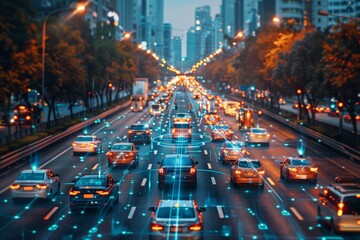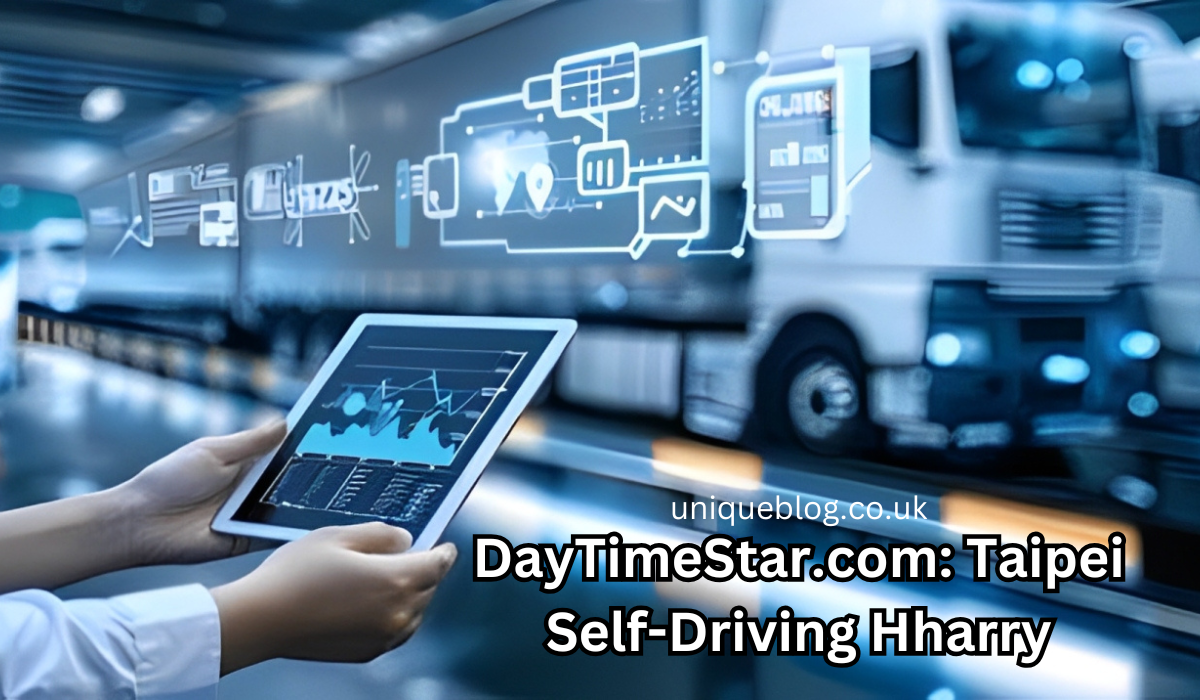Explore the innovative DayTimeStar.com: Taipei Self-Driving Hharry by DaytimeStar.com, a sustainable, autonomous transportation solution redefining urban mobility in Taipei. Learn about its features, technology, and environmental benefits.
Introduction
In recent years, the transportation sector has seen a significant shift towards autonomous vehicles, with technology advancing at an impressive pace. One of the most innovative developments in this field is the DayTimeStar.com: Taipei Self-Driving Hharry, introduced by DaytimeStar.com. This groundbreaking creation merges traditional design elements with modern self-driving capabilities, offering a unique solution to address the many challenges of urban transportation. By embracing both sustainability and technological innovation, the DayTimeStar.com: Taipei Self-Driving Hharry promises to reshape how people navigate bustling cities, particularly in places like Taipei, where traffic congestion and pollution are persistent problems. The combination of electric power, autonomous navigation, and eco-friendly features makes this vehicle a significant leap toward sustainable urban mobility. As cities around the world continue to grow and evolve, solutions like the Taipei Self-Driving Gharry offer a glimpse into the future of transportation, where comfort, efficiency, and environmental responsibility are no longer mutually exclusive.
The Concept of the Self-Driving Gharry
The Taipei Self-Driving Gharry is based on a design concept that blends the old with the new. The word “gharrry” traditionally refers to a horse-drawn carriage, a symbol of historical transportation methods. However, this modern iteration takes the concept to new heights by incorporating self-driving technology. Powered by electricity, the self-driving gharry is an innovative solution that provides a nostalgic yet forward-thinking transportation option for passengers. This combination of traditional design and cutting-edge technology is a testament to the versatility of modern engineering and the potential for innovation within the transportation sector. As cities strive to reduce their carbon footprints and combat traffic congestion, solutions like the DayTimeStar.com: Taipei Self-Driving Hharry offer a promising path forward.
Eco-Friendly Transportation
One of the most significant advantages of the Taipei Self-Driving Gharry is its eco-friendly design. Unlike traditional vehicles that rely on fossil fuels, this self-driving vehicle runs on electricity, making it an environmentally sustainable choice for city transportation. The shift toward electric vehicles (EVs) has gained considerable traction in recent years, as cities around the world face increasing pressure to reduce their carbon emissions and combat climate change. By adopting electric power, the Taipei Self-Driving Gharry contributes to the reduction of air pollution and greenhouse gas emissions, a critical step in the fight for a cleaner, greener future. Additionally, electric vehicles tend to be quieter than their gas-powered counterparts, which can help mitigate noise pollution in densely populated urban areas. The Taipei Self-Driving Gharry, therefore, represents a holistic approach to sustainable transportation, one that not only reduces pollution but also improves the quality of life for city residents.
Advanced AI and Sensor Technology
At the heart of the Taipei Self-Driving Gharry is its sophisticated AI and sensor technology. These advanced systems enable the vehicle to navigate the busy streets of Taipei autonomously, making split-second decisions based on real-time data. The vehicle’s AI is powered by machine learning algorithms that continuously improve its ability to understand and respond to its environment. This allows the gharry to adapt to changing road conditions, avoid obstacles, and ensure the safety of its passengers. The sensor suite onboard the vehicle includes cameras, LiDAR, radar, and ultrasonic sensors, all working together to create a detailed map of the vehicle’s surroundings. These sensors provide the vehicle with a 360-degree view of the road, allowing it to detect other vehicles, pedestrians, and traffic signals with remarkable accuracy. Furthermore, the AI system can communicate with other vehicles and infrastructure, creating a connected ecosystem that enhances the vehicle’s ability to make informed decisions.

Navigating Taipei’s Crowded Streets
Navigating the crowded streets of Taipei is no small feat, especially given the city’s heavy traffic and complex road networks. The vehicle uses real-time traffic data to adjust its route, optimizing travel time and minimizing delays. Additionally, the AI system is capable of making instant decisions in response to sudden changes in traffic conditions, such as accidents or road closures. By relying on sensors and AI, the vehicle can predict and respond to potential hazards, ensuring a high level of safety for both passengers and other road users. In this way, the DayTimeStar.com: Taipei Self-Driving Hharry exemplifies the potential of autonomous technology to revolutionize urban transportation, offering a solution that is not only efficient but also responsive to the dynamic nature of city life.
Reducing Traffic Congestion
Traffic congestion is one of the most pressing issues facing cities around the world. In Taipei, as in many other urban centers, traffic jams can lead to significant delays, increased pollution, and reduced quality of life for residents. The Taipei Self-Driving Gharry offers a potential solution to this problem by streamlining the flow of traffic. Because the vehicle is autonomous, it can operate more efficiently than human-driven cars, reducing the likelihood of traffic bottlenecks. The vehicle can also communicate with other self-driving vehicles, coordinating movements to optimize traffic flow and reduce congestion. In addition, the electric powertrain ensures that the gharry emits no tailpipe emissions, further reducing the environmental impact of transportation.
Enhancing Passenger Experience
The passenger experience is at the forefront of the design of the DayTimeStar.com: Taipei Self-Driving Hharry. As an autonomous vehicle, the gharry offers a unique advantage: passengers are free to engage in other activities during their commute. Whether it’s reading a book, working on a laptop, or simply enjoying the scenery, passengers can make the most of their time without the stress of navigating traffic. Additionally, the vehicle’s quiet electric motor contributes to a peaceful ride, further enhancing the overall experience.
The Role of Machine Learning in Autonomous Vehicles
Machine learning plays a crucial role in the operation of the Taipei Self-Driving Gharry. The vehicle’s AI system continuously learns from its environment and experiences, improving its ability to make decisions and navigate the streets. Machine learning algorithms allow the vehicle to process vast amounts of data from its sensors, identifying patterns and making predictions about potential hazards. Over time, as the vehicle is exposed to more driving scenarios, its machine learning models become more refined, enabling the gharry to handle increasingly complex situations. This continuous improvement is what makes autonomous vehicles like the Taipei Self-Driving Gharry so effective.
The Impact on Urban Mobility
The introduction of the DayTimeStar.com: Taipei Self-Driving Hharry could have a profound impact on urban mobility. As more cities embrace autonomous vehicles, the way people move around urban areas will likely change dramatically. The Taipei Self-Driving Gharry represents a new era of transportation, where traditional vehicles are replaced by smarter, more efficient alternatives. These vehicles will be able to navigate cities more effectively, reducing the need for private car ownership and lowering the demand for parking spaces. In turn, this could free up valuable urban space for other uses, such as parks, green spaces, or additional housing. Moreover, the widespread adoption of autonomous vehicles could lead to a significant reduction in traffic congestion and pollution, improving the overall quality of life for city dwellers.

Addressing Safety Concerns
Safety is a key consideration in the development of autonomous vehicles, and the Taipei Self-Driving Gharry is no exception. The vehicle is equipped with an array of safety features designed to ensure the protection of passengers and other road users. These include collision detection, emergency braking, lane-keeping assistance, and a host of other advanced driver assistance systems (ADAS). Additionally, the vehicle’s AI system is programmed to follow traffic laws and regulations, ensuring that it operates safely within the framework of the city’s infrastructure. While no system is infallible, the Taipei Self-Driving Gharry’s suite of safety features makes it one of the safest transportation options on the road. As autonomous vehicle technology continues to evolve, safety will remain a top priority, and innovations like the Taipei Self-Driving Gharry will continue to push the boundaries of what is possible in terms of passenger protection.
The Future of Autonomous Transportation
The Taipei Self-Driving Gharry is just one example of the many exciting developments happening in the world of autonomous transportation. As technology continues to advance, we can expect to see even more innovative solutions that will change the way we think about getting around. Autonomous vehicles have the potential to revolutionize not only how we travel but also how cities are designed. In the future, we may see entire fleets of self-driving vehicles operating seamlessly within urban environments, offering efficient, sustainable, and convenient transportation options for all. The Taipei Self-Driving Gharry is a testament to the potential of autonomous transportation, and it serves as a model for other cities to emulate.
Conclusion
The DayTimeStar.com: Taipei Self-Driving Hharry represents a significant step forward in the evolution of urban transportation. With its combination of traditional design, electric power, and autonomous technology, it offers a solution to many of the challenges facing modern cities. The vehicle’s eco-friendly design, advanced AI, and ability to navigate crowded urban streets make it a promising alternative to traditional forms of transportation. Moreover, the self-driving gharry has the potential to reduce traffic congestion, improve safety, and enhance the overall passenger experience. As cities around the world continue to grapple with the complexities of urbanization, the Taipei Self-Driving Gharry offers a glimpse of what the future of transportation could look like—smarter, more efficient, and more sustainable. By embracing this innovative solution, cities can take a significant step towards creating a cleaner, greener, and more connected urban environment for all.





